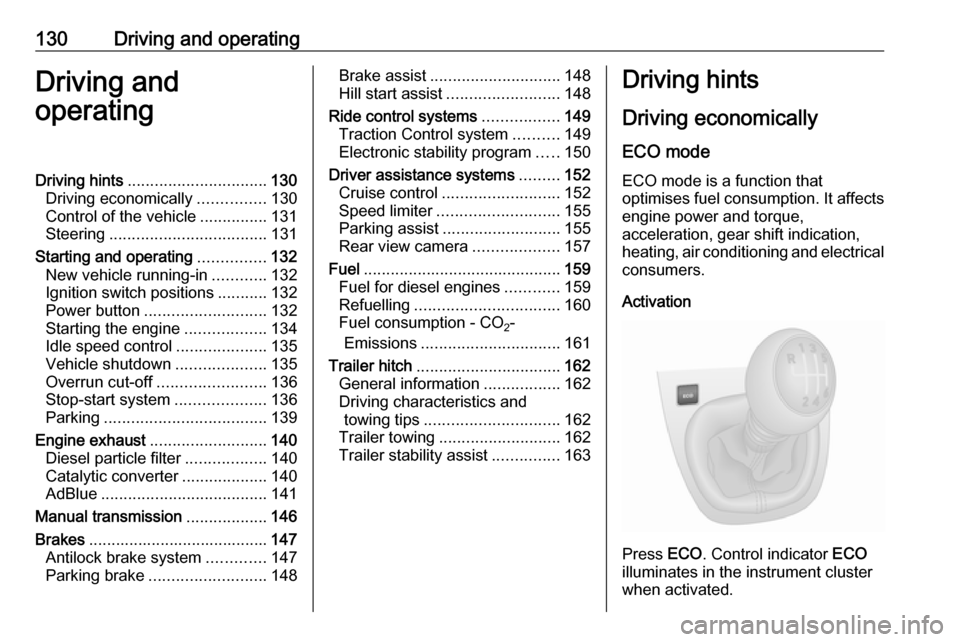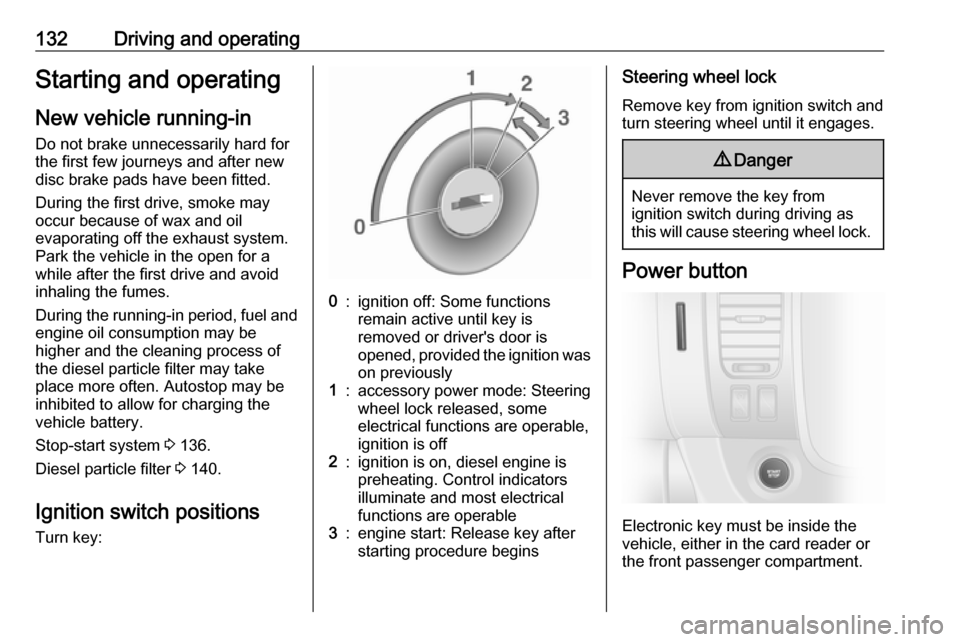power steering OPEL VIVARO B 2018 Manual user
[x] Cancel search | Manufacturer: OPEL, Model Year: 2018, Model line: VIVARO B, Model: OPEL VIVARO B 2018Pages: 237, PDF Size: 5.57 MB
Page 13 of 237

In brief111Side air vents ...................... 127
2 Ashtray .................................. 90
Cupholder ............................ 75
3 Light switch ........................ 108
Rear fog light ....................... 112
Front fog lights ...................111
Exit lighting .......................... 114
Turn and lane-change
signals ................................. 111
Sidelights ............................ 108
Headlight flash, low beam
and high beam ....................109
4 Instruments .......................... 91
Driver Information Centre .... 102
Trip computer .....................105
5 Horn ...................................... 85
Driver airbag ......................... 636Windscreen wiper,
windscreen washer system ..86
Rear window wiper, rear
window washer system ........87
Trip computer .....................105
7 Card reader for electronic
key system ............................ 24
8 Steering column controls ......85
9 Centre air vents ................... 127
10 Power outlet .......................... 88
Cigarette lighter ..................... 90
Coin tray, USB slot ................ 73
11 Info display .......................... 102
12 Front passenger airbag .........63
13 Glovebox .............................. 74
14 Heated exterior mirrors .........41
Heated rear window ..............45
Idle speed control ...............135
15 Power outlet .......................... 88
Cigarette lighter ..................... 9016 Climate control system ........ 116
Electronic climate control
system ................................. 118
17 Ashtray .................................. 90
Cupholder ............................ 75
18 Hazard warning flashers .....111
Central locking system ..........26
19 Power button for electronic
key system .......................... 132
20 Eco button for fuel
economy mode ...................130
21 Stop-start system ................136
Cruise control and speed
limiter ................................. 152
22 Remote control on
steering wheel ......................85
Cruise control .....................152
23 Ignition switch with
steering wheel lock .............132
24 Steering wheel adjustment ...85
25 Bonnet release lever ...........166
26 Fuse box ............................. 182
Page 21 of 237

In brief19Starting the engine with key
● Turn key to position 1.
● Move the steering wheel slightly to release the steering wheel
lock.
● Operate clutch and brake pedal. ● Do not operate accelerator pedal.
● Diesel engines: turn the key to position 2 for preheating and wait
until control indicator !
extinguishes in the instrument
cluster.
● Turn key to position 3 and
release.
Starting the engine 3 134.
Starting the engine with the power
button
Electronic key must be inside the
vehicle, either in the card reader or
the front passenger compartment.
● Move the steering wheel slightly to release the steering wheel
lock.
● Operate clutch and brake pedal.
● Do not operate accelerator pedal.
● Press START/STOP and
release.
● Engine starts after a short delay.
Power button 3 132.
Stop-start system
If the vehicle is at low speed or in
standstill and certain conditions are
fulfilled, activate an Autostop as
follows:
● Depress the clutch pedal.
● Move the selector lever to neutral.
● Release the clutch pedal.
An Autostop is indicated when Ï
illuminates in the instrument cluster
3 101.
To restart the engine, depress the
clutch pedal again.
Stop-start system 3 136.
Page 86 of 237

84Instruments and controlsInstruments and
controlsControls ....................................... 85
Steering wheel adjustment ........85
Steering wheel controls .............85
Horn ........................................... 85
Steering column controls ...........85
Windscreen wiper/washer .........86
Rear window wiper/washer .......87
Outside temperature ..................87
Clock ......................................... 88
Power outlets ............................. 88
Cigarette lighter ......................... 90
Ashtrays .................................... 90
Warning lights, gauges and indi‐ cators ........................................... 91
Instrument cluster ......................91
Speedometer ............................. 91
Odometer .................................. 91
Trip odometer ............................ 91
Tachometer ............................... 92
Fuel gauge ................................ 92
Fuel economy gauge .................93
Service display .......................... 93
Control indicators ......................94
Turn signal ................................. 96Seat belt reminder.....................97
Airbag and belt tensioners .........97
Airbag deactivation ....................97
Charging system .......................98
Malfunction indicator light ..........98
Service vehicle soon .................98
Stop engine ............................... 98
Brake system ............................. 98
Antilock brake system (ABS) .....99
Upshift ....................................... 99
Electronic Stability Program ......99
Electronic Stability Program off ............................................. 99
Engine coolant temperature ......99
Preheating ............................... 100
AdBlue ..................................... 100
Tyre pressure monitoring system .................................... 100
Engine oil pressure ..................100
Fuel economy mode ................101
Low fuel ................................... 101
Stop-start system ....................101
Exterior light ............................ 101
High beam ............................... 101
Fog light ................................... 101
Rear fog light ........................... 101
Cruise control .......................... 102
Tachograph ............................. 102
Door open ................................ 102Information displays...................102
Driver Information Centre ........102
Info display .............................. 102
Vehicle messages ......................103
Warning chimes .......................104
Engine oil level ........................ 104
Trip computer ............................. 105
Tachograph ................................ 107
Page 132 of 237

130Driving and operatingDriving and
operatingDriving hints ............................... 130
Driving economically ...............130
Control of the vehicle ...............131
Steering ................................... 131
Starting and operating ...............132
New vehicle running-in ............132
Ignition switch positions ...........132
Power button ........................... 132
Starting the engine ..................134
Idle speed control ....................135
Vehicle shutdown ....................135
Overrun cut-off ........................ 136
Stop-start system ....................136
Parking .................................... 139
Engine exhaust .......................... 140
Diesel particle filter ..................140
Catalytic converter ...................140
AdBlue ..................................... 141
Manual transmission ..................146
Brakes ........................................ 147
Antilock brake system .............147
Parking brake .......................... 148Brake assist............................. 148
Hill start assist ......................... 148
Ride control systems .................149
Traction Control system ..........149
Electronic stability program .....150
Driver assistance systems .........152
Cruise control .......................... 152
Speed limiter ........................... 155
Parking assist .......................... 155
Rear view camera ...................157
Fuel ............................................ 159
Fuel for diesel engines ............159
Refuelling ................................ 160
Fuel consumption - CO 2-
Emissions ............................... 161
Trailer hitch ................................ 162
General information .................162
Driving characteristics and towing tips .............................. 162
Trailer towing ........................... 162
Trailer stability assist ...............163Driving hints
Driving economically
ECO mode ECO mode is a function that
optimises fuel consumption. It affects
engine power and torque,
acceleration, gear shift indication,
heating, air conditioning and electrical consumers.
Activation
Press ECO. Control indicator ECO
illuminates in the instrument cluster when activated.
Page 133 of 237

Driving and operating131Note
The use of ECO mode may affect the
performance of the climate control
system 3 116.
During driving, it is possible to
temporarily disable ECO mode, e.g.
to increase engine performance, by
depressing the accelerator pedal
firmly.
ECO mode is reactivated when
pressure is reduced on the
accelerator pedal.
Deactivation
Press ECO again. Control indicator
ECO extinguishes in the instrument
cluster.
Control of the vehicle
Never coast with engine not
running (except during Autostop)
Many systems will not function in this
situation (e.g. brake servo unit, power steering). Driving in this manner is a
danger to yourself and others. All
systems function during an Autostop,
but there may be a controlled
reduction in power steering assist and
vehicle speed is reduced.
Stop-start system 3 136.
Pedals
To ensure the pedal travel is
uninhibited, there must be no mats in the area of the pedals.
Use only floor mats which fit properly and are fixed by the retainers on the
driver's side.
Driving downhill
Engage a gear when driving downhill
to ensure that sufficient brake
pressure is available.Steering
If power steering assist is lost
because the engine stops or due to a
system malfunction, the vehicle can
be steered but may require increased
effort.Caution
Vehicles equipped with hydraulic
power steering:
If the steering wheel is turned until it reaches the end of its travel, and
is held in that position for more
than 15 seconds, damage may
occur to the power steering
system and there may be loss of
power steering assist.
Page 134 of 237

132Driving and operatingStarting and operating
New vehicle running-in
Do not brake unnecessarily hard for
the first few journeys and after new
disc brake pads have been fitted.
During the first drive, smoke may
occur because of wax and oil
evaporating off the exhaust system.
Park the vehicle in the open for a
while after the first drive and avoid
inhaling the fumes.
During the running-in period, fuel and engine oil consumption may be
higher and the cleaning process of
the diesel particle filter may take
place more often. Autostop may be
inhibited to allow for charging the
vehicle battery.
Stop-start system 3 136.
Diesel particle filter 3 140.
Ignition switch positions
Turn key:0:ignition off: Some functions
remain active until key is
removed or driver's door is
opened, provided the ignition was on previously1:accessory power mode: Steering
wheel lock released, some
electrical functions are operable,
ignition is off2:ignition is on, diesel engine is
preheating. Control indicators
illuminate and most electrical
functions are operable3:engine start: Release key after
starting procedure beginsSteering wheel lock
Remove key from ignition switch and
turn steering wheel until it engages.9 Danger
Never remove the key from
ignition switch during driving as
this will cause steering wheel lock.
Power button
Electronic key must be inside the
vehicle, either in the card reader or
the front passenger compartment.
Page 135 of 237

Driving and operating133If the electronic key is not inside the
vehicle, a corresponding message
appears in the Driver Information
Centre 3 102.
Note
Do not put the electronic key in the
load compartment during driving, as
this is outside of the detection zone
(indicated by a warning chime at low
speed 3 104 and a message in the
Driver Information Centre 3 103).
Note
In the event the electronic key is kept in the front passenger compartment
and a message appears in the Driver
Information Centre (possibly
accompanied by a warning chime) indicating that it is out of reception
range, we recommend inserting the
electronic key in the card reader.
Some functions, e.g. Infotainment
system, are available for use as soon
as you enter the vehicle.Accessory power mode
Press START/STOP without
operating clutch or brake pedal to
enable further electrical functions to
be operated.
These functions switch off
automatically after a delay.
Engine start
Operate clutch and brake pedal and
press START/STOP . Release button
after starting procedure begins.
If a gear is engaged, the engine can
be started only by operating the clutch
pedal and pressing the
START/STOP button.
In some cases, it may be necessary
to move the steering wheel slightly
while pressing START/STOP to
release the steering wheel lock. A
corresponding message appears in
the Driver Information Centre 3 102.
At very low outside temperatures (e.g. below -10 °C) keep the clutch pedal
depressed while pressing
START/STOP until the engine starts.If one of the starting conditions is not
applied, a corresponding message
appears in the Driver Information
Centre 3 102.
Vehicle messages 3 103.
Engine stop
Electronic key must be inside the
vehicle, either in the card reader or the front passenger compartment.
With the vehicle stationary, press
START/STOP to stop the engine. The
steering wheel lock is engaged when
the driver's door is opened and the
vehicle is locked.
If the electronic key is not detected, a corresponding message appears in
the Driver Information Centre 3 102.
In this event, press START/STOP for
two seconds to stop the engine.
Central locking system 3 26.
Retained power off
Press START/STOP for more than
two seconds; the engine is stopped
while some functions, e.g.
Infotainment system, are available for
use for approx. 10 minutes.
Page 139 of 237

Driving and operating137Note
When the fast idle function is
activated, the stop-start system is
automatically deactivated and
cannot be reactivated by pressing
Î . LED in button illuminates to
indicate deactivation and a
corresponding message may
appear in the Driver Information
Centre 3 102.
Idle speed control 3 135.
Depending on version, if the driver's
door is opened or the driver's seat belt
is unfastened, the stop-start system is
deactivated automatically, and the
engine is switched off. Restart engine by pressing START/STOP .
Power button 3 132.
Autostop If the vehicle is at a low speed or at astandstill, activate an Autostop as
follows:
● depress the clutch pedal
● move the selector lever to neutral
● release the clutch pedalThe engine will be switched off while
the ignition stays on if the required conditions are met.
An Autostop is indicated when Ï
illuminates in the instrument cluster
3 101.
During an Autostop, heating and brake performance will be
maintained. Brake assist, however, is
not available 3 148.
Caution
The power steering assist may be
reduced during an Autostop.
If you exit the vehicle while the engine is in an Autostop, a warning chime will
sound and a message " IGNITION
OFF " is displayed in the Driver
Information Centre as a reminder that
the engine is on standby and has not
been switched off.
Conditions for an Autostop
The stop-start system checks if each
of the following conditions is fulfilled,
otherwise an Autostop will be
inhibited and control indicator \ will
illuminate in the instrument cluster:
● the stop-start system is not manually deactivated
● the bonnet is fully closed
● the driver's door is closed or the driver's seat belt is fastened
● the vehicle battery is sufficiently charged and in good condition
● the engine is warmed up
● the engine coolant temperature is
not too high
● the outside temperature is not too
low or too high (e.g. below 0 °C
or above 30 °C)
Page 165 of 237

Driving and operating163level. Since engine power decreases
as altitude increases due to the air
becoming thinner, therefore reducing
climbing ability, the permissible gross
train weight also decreases by 10%
for every 1000 metres of additional
altitude. The gross train weight does
not have to be reduced when driving
on roads with slight inclines (less than
8%, e.g. motorways).
The permissible gross train weight
must not be exceeded. This weight is
specified on the identification plate
3 208.
Vertical coupling load
The vertical coupling load is the load
exerted by the trailer on the coupling
ball. It can be varied by changing the
weight distribution when loading the
trailer.
The maximum permissible vertical
coupling load is specified on the
towing equipment identification plate
and in the vehicle documents. Always aim for the maximum load, especially
in the case of heavy trailers. The
vertical coupling load should never
fall below 25 kg.In the case of trailer loads of
1200 kg or more, the vertical coupling load should not be less than 50 kg.
Rear axle load
When the trailer is coupled and the
towing vehicle fully loaded (including
all occupants), the permissible rear
axle load (see identification plate or
vehicle documents) must not be
exceeded.
Trailer stability assist
If the system detects snaking
movements, engine power is reduced
and the vehicle/trailer combination is selectively braked until the snaking
ceases. While the system is working, keep steering wheel as still as
possible.
Trailer stability assist (TSA) is a
function of the Electronic Stability
Program (ESP® Plus
) 3 150.
Page 166 of 237

164Vehicle careVehicle careGeneral Information...................165
Accessories and vehicle modifications .......................... 165
Vehicle storage ........................165
End-of-life vehicle recovery .....166
Vehicle checks ........................... 166
Performing work ......................166
Bonnet ..................................... 166
Engine oil ................................. 167
Engine air filter ........................ 168
Engine coolant ......................... 169
Power steering fluid .................169
Washer fluid ............................ 170
Brakes ..................................... 170
Brake fluid ............................... 170
Vehicle battery ......................... 171
Diesel fuel filter ........................173
Diesel fuel system bleeding .....173
Wiper blade replacement ........174
Bulb replacement .......................175
Headlights ............................... 175
Fog lights ................................. 176
Front turn signal lights .............176
Tail lights ................................. 176
Side turn signal lights ..............177Centre high-mounted brake
light ......................................... 177
Reversing light ......................... 178
Number plate light ...................179
Fog tail light ............................. 179
Interior lights ............................ 180
Instrument panel illumination ...180
Electrical system ........................181
Fuses ....................................... 181
Instrument panel fuse box .......182
Vehicle tools .............................. 185
Tools ........................................ 185
Wheels and tyres .......................186
Tyres ....................................... 186
Winter tyres ............................. 186
Tyre designations ....................186
Tyre pressure .......................... 186
Tyre pressure monitoring system .................................... 188
Tread depth ............................. 190
Changing tyre and wheel size . 190
Wheel covers ........................... 190
Tyre chains .............................. 191
Tyre repair kit .......................... 191
Wheel changing .......................194
Spare wheel ............................ 195
Jump starting ............................. 197Towing....................................... 198
Towing the vehicle ...................198
Towing another vehicle ...........199
Appearance care .......................200
Exterior care ............................ 200
Interior care ............................. 202